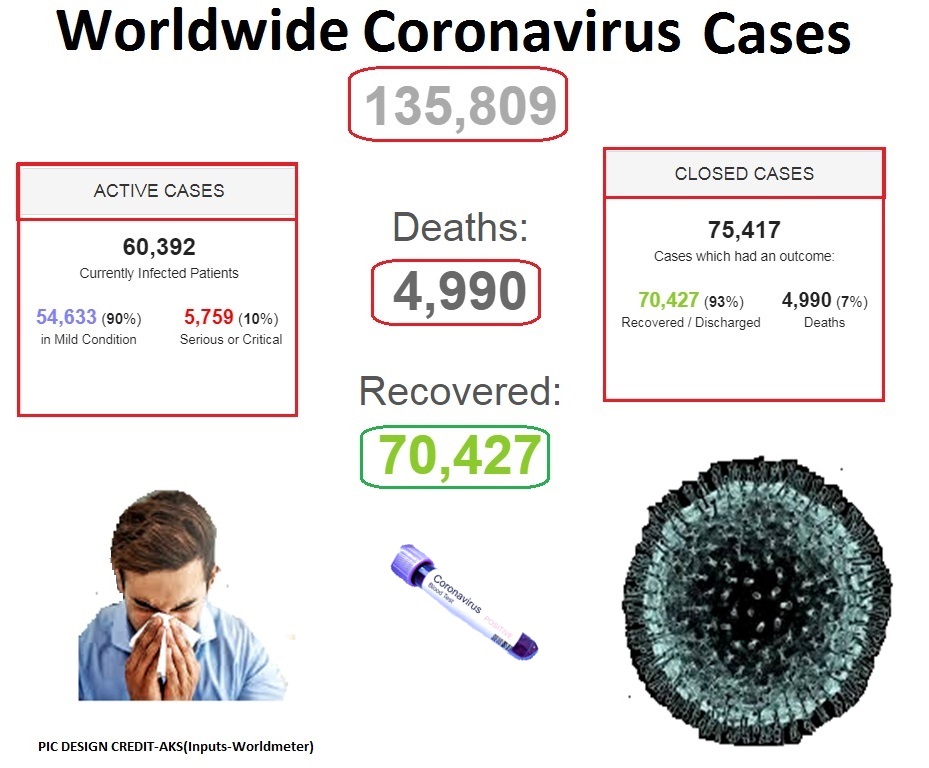It’s the time for ‘Quarantine’ not mere ‘Isolation’ : COVID-19

As the Coronavirus turned from an ‘Epidemic’ to ‘Pandemic’within a very short span of time, so the bare need of the world now is ‘Quarantine’ not mere isolation.
|| Anjan KumarSamal
When discussing the spread of disease, isolation refers to separating sick individuals from society in order to contain the spread of the illness. And in this much lethal cases of Corona ridden world today , mere isolation must not work out in curbing this Pandemic under whose claws the entire world is in the brink of fear.
Quarantine refers to separating and restricting the movements of healthy individuals who may have been exposed to an illness to determine whether they are sick (and would require “isolation”).
Therefore each and every nation in this world should now believe in complete Quarantine not mere trust on their responsibility of Complete isolation.
The hunt of Corona started at first from China and soon it did spread across the globe and the most affected countries are Italy. Iran, South Korea,Spain , france ,Germany and USA.
India ranks 28th among the Corona affected countries in world with total number of corona affected 78 patients. Among 78 cases , 74 are active with a death of 2 patient including Zero number of seriously critical case.
There are as many as 135,809 active cases of coronavirus affected patient world wide.4,990 patients have also died and 70,427 numbers of patients already got recovered.
Coronavirus Symptoms (COVID-19)
Reported illnesses have ranged from people with mild symptoms to people being severely ill and dying.
Symptoms can include:
- Fever
- Cough
- Shortness of breath
Typical Symptoms
COVID-19 typically causes flu-like symptoms including a fever and cough.
In some patients – particularly the elderly and others with other chronic health conditions – these symptoms can develop into pneumonia, with chest tightness, chest pain, and shortness of breath.
It seems to start with a fever, followed by a dry cough.
After a week, it can lead to shortness of breath, with about 20% of patients requiring hospital treatment.
Notably, the COVID-19 infection rarely seems to cause a runny nose, sneezing, or sore throat (these symptoms have been observed in only about 5% of patients). Sore throat, sneezing, and stuffy nose are most often signs of a cold.
80% of cases are mild
Based on all 72,314 cases of COVID-19 confirmed, suspected, and asymptomatic cases in China as of February 11, a paper by the Chinese CCDC released on February 17 and published in the Chinese Journal of Epidemiology has found that:
- 80.9% of infections are mild (with flu-like symptoms) and can recover at home.
- 13.8% are severe, developing severe diseases including pneumonia and shortness of breath.
- 4.7% as critical and can include: respiratory failure, septic shock, and multi-organ failure.
- in about 2% of reported cases the virus is fatal.
- Risk of death increases the older you are.
- Relatively few cases are seen among children.
Examples of possible development of symptoms (from actual cases)
A man in his 40s in Japan:
- Day #1: malaise and muscle pain
- later diagnosed with pneumonia
A man in his 60s in Japan:
- Day #1: initial symptoms of low-grade fever and sore throat.
A man in his 40s in Japan:
- Day #1: chills, sweating and malaise
- Day #4: fever, muscle pain and cough
A woman in her 70s, in Japan:
- Day #1: 38° fever for a few minutes
- Day #2-3: went on a bus tour
- Day #5: visited a medical institution
- Day #6: showed symptoms of pneumonia.
A woman in her 40s, in Japan:
- Day #1: low-grade fever
- Day #2: 38° fever
- Day #6: being treated at home.
A man in his 60s, in Japan:
- Day #1: Cold
- Day #6: Fever of 39° C. (102.2 F)
- Day #8: Pneumonia
Another patient, in China with a history of type 2 diabetes and hypertension:
- Jan. 22: Fever and cough
- Feb. 5: Died
First death in the Philippines (a 44-year-old Chinese thought to have had other pre-existing health conditions):
- Jan. 25: Fever, cough, and sore throat (hospitalized)
- Developed severe pneumonia
- Feb. 2: Died
How long do symptoms last?
Using available preliminary data, the Report of the WHO-China Joint Mission published on Feb. 28 by WHO, [5] which is based on 55,924 laboratory confirmed cases, observed the following median time from symptoms onset to clinical recovery:
- mild cases: approximately 2 weeks
- severe or critical disease: 3 – 6 weeks
- time from onset to the development of severe disease (including hypoxia): 1 week
Among patients who have died, the time from symptom onset to outcome ranges from 2 – 8 weeks.
Symptoms observed in hospitalized patients with COVID-19
Below we list the symptoms, with percentages representing the proportion of patients displaying that symptom, as observed in hospitalized patients tested and identified as having laboratory-confirmed COVID-19 infection. These findings refer to hospitalized patients, therefore generally representing serious or critical cases. The majority of cases of COVID-19 (about 80%) is mild.
Findings from the Wang et al study published on JAMA and based on 138 hospitalized patients
| Common symptoms included: (Wang et al study) |
|
| Fever | 98.6% |
| Fatigue | 69.6% |
| Dry cough | 59.4% |
The median time observed:
- from first symptom to → Dyspnea (Shortness of breath) = 5.0 days
- from first symptom to → Hospital admission = 7.0 days
- from first symptom to → ARDS (Acute Respiratory Distress Syndrome) = 8.0 days (when occurring)
Age, Sex, Existing Conditions of COVID-19 Cases and Deaths
Last updated: February 29, 4:40 GMT
There are two sources that provide age, sex, and co morbidity statistics:
The Report of the WHO-China Joint Mission published on Feb. 28 by WHO, [2] which is based on 55,924 laboratory confirmed cases. The report notes that “The Joint Mission acknowledges the known challenges and biases of reporting crude CFR early in an epidemic”
- A paper by the Chinese CCDC released on Feb. 17, which is based on 72,314 confirmed, suspected, and asymptomatic cases of COVID-19 in China as of Feb. 11, and was published in the Chinese Journal of Epidemiology [1]
We will list data from both, labeling them as “confirmed cases” and “all cases” respectively in the tables.
Age of Coronavirus Deaths
COVID-19 Fatality Rate by AGE:
*Death Rate = (number of deaths / number of cases) = probability of dying if infected by the virus (%). This probability differs depending on the age group. The percentages shown below do not have to add up to 100%, as they do NOT represent share of deaths by age group. Rather, it represents, for a person in a given age group, the risk of dying if infected with COVID-19.
| AGE | DEATH RATE confirmed cases |
DEATH RATE all cases |
| 80+ years old | 21.9% | 14.8% |
| 70-79 years old | 8.0% | |
| 60-69 years old | 3.6% | |
| 50-59 years old | 1.3% | |
| 40-49 years old | 0.4% | |
| 30-39 years old | 0.2% | |
| 20-29 years old | 0.2% | |
| 10-19 years old | 0.2% | |
| 0-9 years old | no fatalities |
*Death Rate = (number of deaths / number of cases) = probability of dying if infected by the virus (%). The percentages do not have to add up to 100%, as they do NOT represent share of deaths by age group.
In general, relatively few cases are seen among children.
Sex ratio
COVID-19 Fatality Rate by SEX:
*Death Rate = (number of deaths / number of cases) = probability of dying if infected by the virus (%). This probability differs depending on sex. When reading these numbers, it must be taken into account that smoking in China is much more prevalent among males. Smoking increases the risks of respiratory complications.
| SEX | DEATH RATE confirmed cases |
DEATH RATE all cases |
| Male | 4.7% | 2.8% |
| Female | 2.8% | 1.7% |
*Death Rate = (number of deaths / number of cases) = probability of dying if infected by the virus (%). The percentages do not have to add up to 100%, as they do NOT represent share of deaths by sex.
Pre-existing medical conditions (co -morbidities)
Patients who reported no pre-existing (“co morbid”) medical conditions had a case fatality rate of 0.9%. Pre-existing illnesses that put patients at higher risk of dying from a COVID-19 infection are:
COVID-19 Fatality Rate by CO-MORBIDITY:
*Death Rate = (number of deaths / number of cases) = probability of dying if infected by the virus (%). This probability differs depending on pre-existing condition. The percentage shown below does NOT represent in any way the share of deaths by pre-existing condition. Rather, it represents, for a patient with a given pre-existing condition, the risk of dying if infected by COVID-19.
| PRE-EXISTING CONDITION | DEATH RATE confirmed cases |
DEATH RATE all cases |
| Cardiovascular disease | 13.2% | 10.5% |
| Diabetes | 9.2% | 7.3% |
| Chronic respiratory disease | 8.0% | 6.3% |
| Hypertension | 8.4% | 6.0% |
| Cancer | 7.6% | 5.6% |
| no pre-existing conditions | 0.9% |
*Death Rate = (number of deaths / number of cases) = probability of dying if infected by the virus (%). The percentages do not have to add up to 100%, as they do NOT represent share of deaths by condition.
(Inputs with Info:-Worldmeter)


